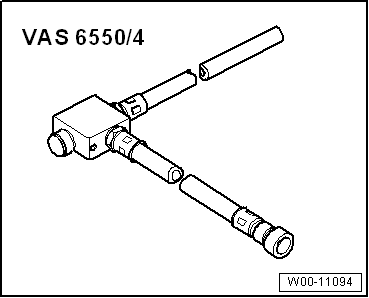Volkswagen Golf Service & Repair Manual: Checking fuel delivery rate, vehicles with four-wheel drive
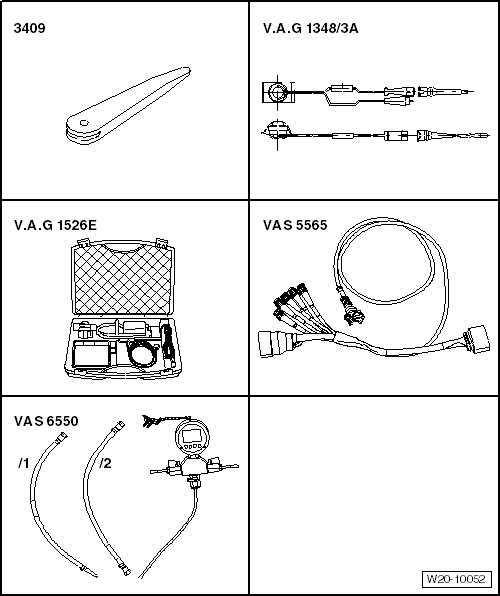
| Special tools and workshop equipment required |
| Remote control for V.A.G. 1348 -V.A.G 1348/3A- |
| Multimeter e.g. hand-held multimeter -V.A.G 1526E- |
| Test instrument adapter/DSO (5-pin) -VAS 5565- |
| Pressure tester -VAS 6550- |
| Vehicle diagnostic tester |
| Connector cable -VAS 6550/3-3- |
| Connector cable -VAS 6550/3-4- |
| Pressure relief valve -VAS 6550/4- |
| Measuring container, capacity ≥ 3 l |
| Auxiliary measuring set -V.A.G 1594C- |
| Carry out the following work: |
| Checking fuel delivery rate in engine
compartment, quick test: |
 Note Note
| The fuel delivery rate must first be checked in the engine
compartment with the help of the function “Checking fuel
delivery rate, quick test”. If the minimum delivery rate is not
achieved, a 2nd measurement must be carried out at the flange of
the fuel delivery unit. |
| – |
Connect vehicle diagnostic tester. |
| – |
Start Guided Functions. |
| – |
Select the function Checking fuel delivery rate, quick test. |
| – |
Follow instructions on vehicle diagnostic tester. |
|
|
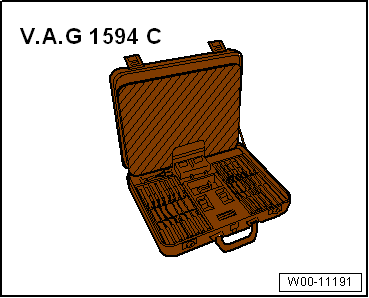
|
| If the specification is not attained: |
| – |
Open tank flap unit -2-. |
| – |
Clean area around fuel filler neck. |
| – |
Unscrew cap -1- for fuel filler
neck. |
| – |
Check fuel delivery rate, repeat quick test
→ Anchor. |
| If specification is attained: |
| – |
Check fuel tank breather
→ Chapter. |
| If the specification is not attained: |
| – |
Check fuel lines for possible restrictions (kinks) or
blockages. |
| – |
Check fuel lines for leaks and damage. |
| Proceed as follows to check fuel delivery rate at fuel
delivery unit: |
| Checking fuel delivery rate at fuel delivery unit: |
 Note Note
| Separate plug-in connectors
→ Chapter. |
| When driving characteristic problems occur when the fuel
tank is a approx. 1/4
filled, then check fuel delivery rates with approx.
1/4
filled tank or less. |
| Voltage supply OK
→ Chapter. |
| Fuel pressure OK
→ Chapter. |
| Battery voltage must be at least 11.5 V. If necessary,
connect battery charger
→ Electrical system; Rep. gr.27. |
| Fuel pump control unit -J538- OK → Vehicle
diagnostic tester. |
| – |
Observe safety precautions
→ Chapter. |
| – |
Observe rules for cleanliness
→ Chapter. |
| – |
Connect battery charger
→ Electrical system; Rep. gr.27. |
| – |
Remove rear bench seat
→ General body repairs, interior; Rep. gr.72. |
|
|
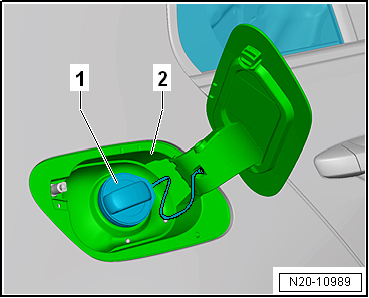
|
| – |
Unclip cover -1- for flange at
retaining tabs -arrows-, using
removal wedge -3409-. |
|
|
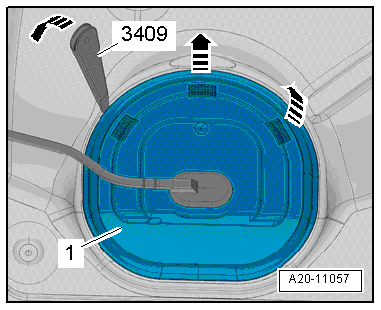
|
| – |
Unclip sealing grommet -1-
downwards from cover -2-. |
| – |
Push cover -2- back along
wiring harness -3-. |
|
|
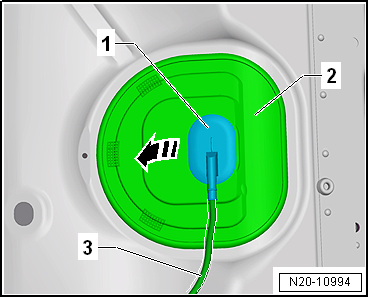
|
| – |
Press up tab -2- in
-direction of arrow A-; to do so,
reach between floor panel and fuel tank with your finger. |
| – |
At the same time, carefully pull fuel pump control unit-1-
out of mounting -in direction of arrow B-
by grasping hold of wiring harness -3-. |
| – |
Guide fuel pump control unit -J538- out towards interior
between fuel tank and floor panel. |
| – |
Place fuel pump control unit -J538- (with connector still
connected) to one side. |
|
|
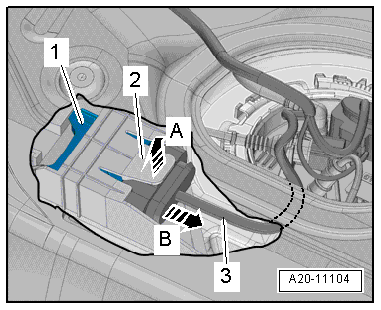
|
| – |
Check that connector -1- is
fitted securely by pulling connector without pressing catch. The
connector can cause a fault if it has not been fitted correctly. |
| – |
Release and pull off connector -1-. |
| – |
Check contacts on plug and on fuel delivery unit for damage. |
|
|
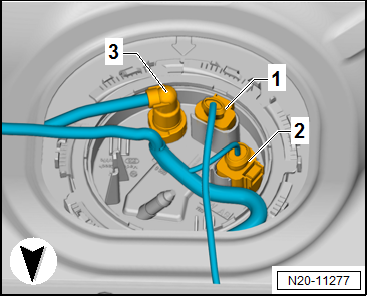
|
| – |
Connect remote control for V.A.G 1348 -V.A.G 1348/3A- with
adapter cable -V.A.G 1348/3-3- to contact
-1- using an auxiliary cable from auxiliary measuring set
-V.A.G 1594C-. |
| – |
Tape off 2nd connector contact of the adapter cable -V.A.G
1348/3-3- with insulating tape -arrow-
to prevent short circuits. |
| – |
Connect contact -2- to negative
battery terminal -A- using a test
lead from auxiliary measuring set -V.A.G 1594C-. |
| – |
Connect remote control -V.A.G 1348/3A- to battery positive
terminal clamp -B-. |
 Note Note
| This step serves only to have the fuel pump running when the
engine is stopped. |
|
|
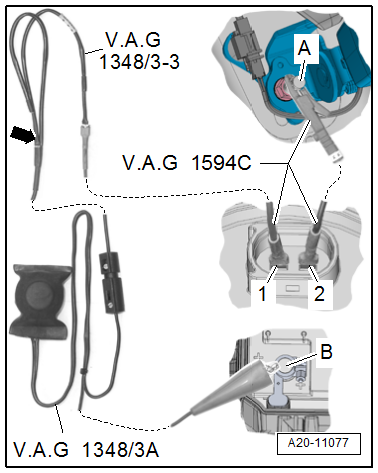
|
| – |
Pull fuel line -3- off flange.
Separate plug-in connectors
→ Chapter. |
The fuel system is pressurised.Risk of injury due to fuel which may
spurt out.Wear eye protection.Wear protective gloves.Release pressure:
place clean cloth around connection and carefully open connection.
| – |
The delivery rate of the fuel pump depends on the battery
voltage. Therefore connect multimeter to the battery. |
| – |
Connect multimeter with auxiliary measuring set -V.A.G
1594C-. |
|
|

|
| – |
Connect pressure tester -VAS 6550- with hose -VAS 6550/3-4-
to fuel delivery unit -1-. |
| – |
Connect hose -VAS 6550/3-4- to shut-off tap
-A-. |
| – |
Connect pressure relief valve -VAS 6550/4- to connection
-B- of pressure tester -VAS 6550- |
| – |
Hold end of hose of pressure relief valve -VAS 6550/4- in
measuring container. |
|
|
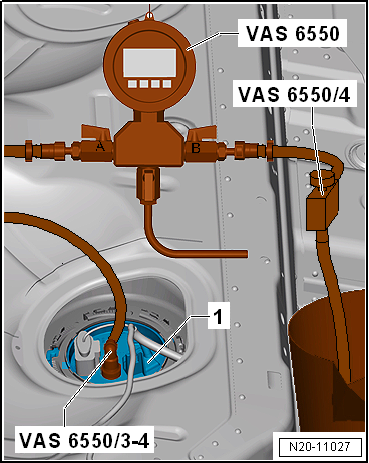
|
| – |
Ensure that drain tap -C- on
pressure tester-1- is closed. |
| – |
Shut-off valves -A- and
-B- on pressure tester-1-
are open. |
| – |
Press remote control -V.A.G 1348/3A-. |
 Note Note
| The fuel system pressurisation pump -G6- will be actuated. |
|
|
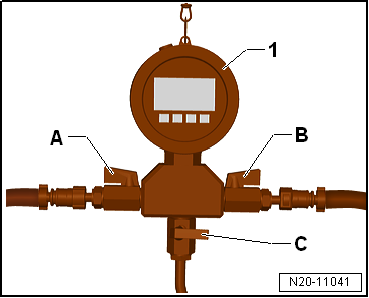
|
| – |
Set pressure of 4.0 bar on pressure relief valve-arrow-
using adjuster wheel. |
| – |
Keep the adjuster wheel in this position from this point on. |
| – |
Drain measuring container. |
| – |
Press remote control for 60 seconds whilst measuring voltage
at fuel pump. |
|
|
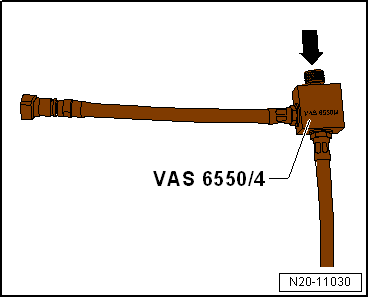
|
| – |
Compare delivered quantity of fuel with specification
indicated in chart. |
|
|
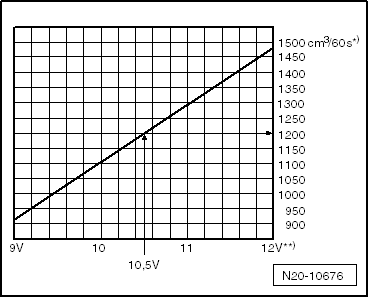
|
| Name of axis |
Unit |
| Minimum delivery rate |
cm3 |
| Voltage at fuel pump with
engine not running and pump running. |
Volt |
| During the test a voltage of 10.5 volts is measured. This
equates to a minimum delivery rate of approx. 1,200 cm3
in 60 seconds. |
| If specification is attained: |
| – |
Check fuel lines for possible restrictions (kinks) or
blockages. |
| – |
Check fuel lines for leaks and damage. |
| If the specification is not attained: |
| – |
Remove fuel delivery unit
→ Chapter. |
|
|
|
| – |
Check filter strainer for soiling. |
| – |
Check that all fuel delivery unit -1-
hose connections -arrows- are
connected. |
| – |
Check fuel lines for possible restrictions (kinks) or
blockages. |
| – |
Check fuel lines for leaks and damage. |
| – |
Renew fuel delivery unit
→ Chapter. |
|
|
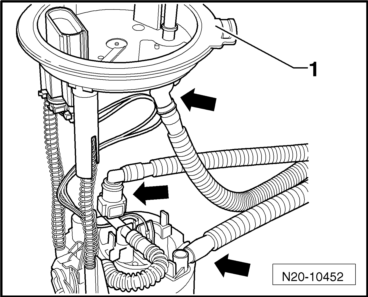
|
Special tools and workshop equipment required
Removal wedge -3409-
Remote control for V.A.G. 1348 -V.A.G 1348/3A-
Multimeter e.g. hand-h ...
Special tools and workshop equipment
required
Removal wedge -3409-
Procedure:
...
Other materials:
Assembly overview - roof spoiler
1 -
Roof spoiler
Material PC/PET
With foam strip serving as intermediate piece
With 4 fasteners with foam ring
Removing and installing
→ Chapter
2 -
Right side spoiler
With adhesive tape
Removing and installin ...
Interior mirror
Fig. 92 On the windscreen: automatic anti-dazzle
interior mirror
Fig. 93 On the windscreen: manual anti-dazzle
interior mirror
First read and observe the introductory information
and safety warnings The driver must adjust the interior mirror to ensure
clear visibility through the rear ...
Assembly overview - anti-roll bar, multi-link suspension, four-wheel drive
1 -
Lower transverse link
2 -
Nut
Renew after removing
20 Nm +180°
3 -
Coupling rod
Removing and installing
→ Chapter
4 -
...
© 2016-2025 Copyright www.vwgolf.org


 Note
Note Note
Note Note
Note Note
Note Checking fuel delivery rate, engine code CWVA
Checking fuel delivery rate, engine code CWVA Removing and installing fuel pump control unit -J538-
Removing and installing fuel pump control unit -J538-
